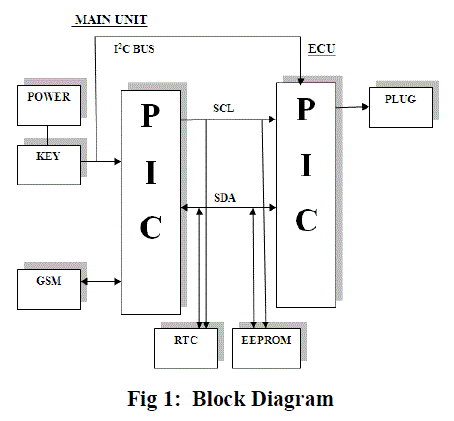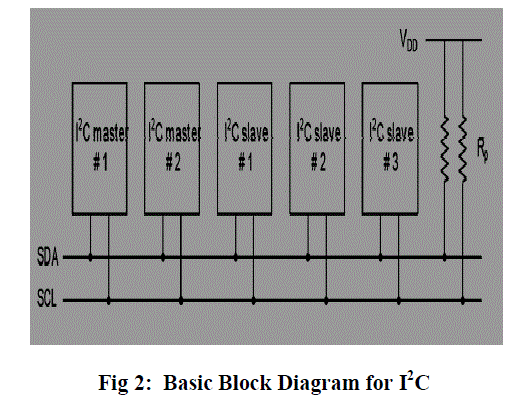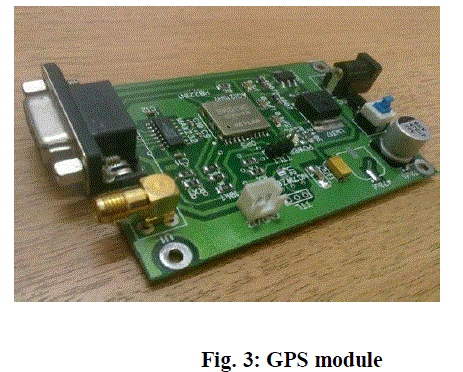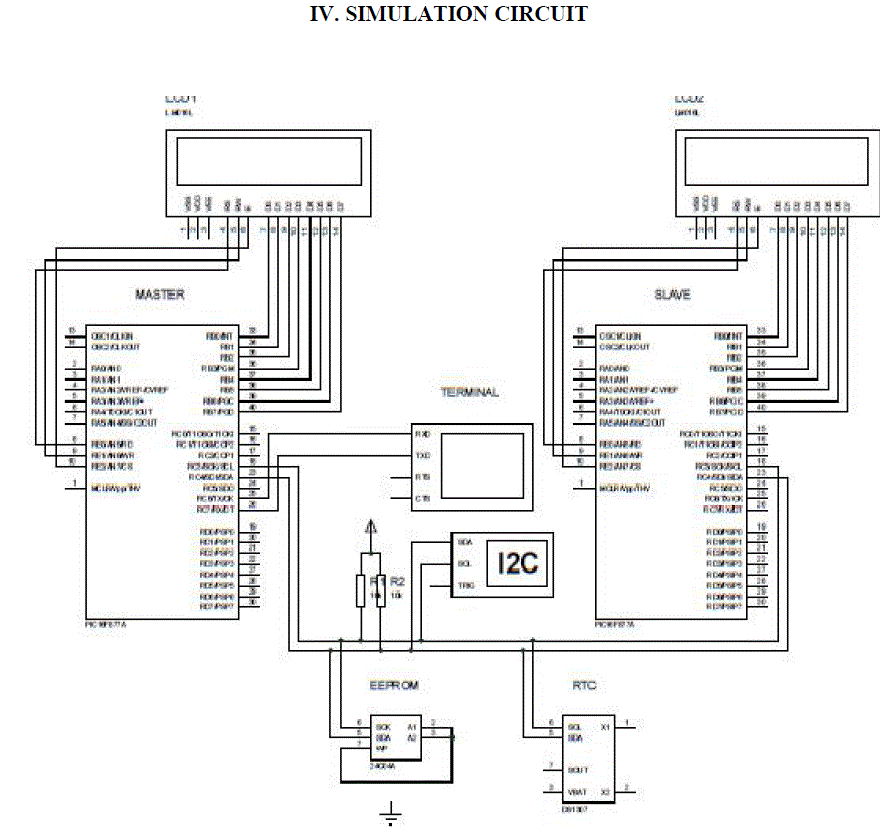ISSN ONLINE(2278-8875) PRINT (2320-3765)
ISSN ONLINE(2278-8875) PRINT (2320-3765)
Glory Priyadharshini. J1 and C. K. Vijaya lakshmi2
|
| Related article at Pubmed, Scholar Google |
Visit for more related articles at International Journal of Advanced Research in Electrical, Electronics and Instrumentation Engineering
Nowadays evasion from due payment of automobile loan, vehicle insurance is an ordinary affair. This paper deals with the design & development of an advanced vehicle locking system in the real time environment based on the loan / Insurance details. The proposed system consists of an PIC16F877A and GSM module that is embedded in the vehicle with an interfacing to Engine Control Unit (ECU) through I2C Bus which is in turn, communicated to the ECU. The ECU will allow starting the vehicle only after receiving the fair signals from the PIC controller. If the user attempts to remove the PIC controller unit, the fair signal won’t get received by the ECU and thereby the engine will not ignite. In this proposed work, Real Time Clock (RTC) and EEPROM data will automatically lock the vehicle on the every 30th day of the month. The engine can be unlocked only by the banker / insurer by sending the due clearance confirmation message. It makes the way for the prompt payment of the dues by the customer. Inculcating hardware implementation, ensuring vehicle security, user friendliness are some of the valuable features enlisted in this project. PROTEUS software is used for simulation and MP LAB for compilation. Theft protection can also be added as future work.
Keywords |
| Vehicle Tracking, Locking, Microcontroller, GPS, GSM, ECU |
INTRODUCTION |
| In the last few decades, India has progressed at such an enormous rate that many companies have strongly established themselves here. These companies bring a huge amount of workforce with them. Arranging transportation to such a huge mass is a cumbersome task involving many intricacies. Generally, this transport is arranged through the local transport vendors on a yearly contract basis, recently happen mishaps such as burglary, rape cases etc. The development of satellite communication technology is easy to identify the vehicle locations. Vehicle tracking systems have brought this technology to the day-to-day life of the common person. Today GPS used in cars, ambulances, fleets and police vehicles are common sights on the roads of developed countries. |
| The GPS/GSM Based System is one of the most important systems, which integrate both GSM and GPS technologies. It is necessary due to the many of applications of both GSM and GPS systems and the wide usage of them by millions of people throughout the world. This system designed for users in land construction and transport business, provides real-time information. The real time information collected is location, speed and expected arrival time of the user is moving vehicles in a concise and easy-to-read format. This system may also useful for communication process among the two points. Currently GPS vehicle tracking ensures their safety as travelling. This vehicle tracking system found in clients vehicles as a theft prevention and rescue device. Vehicle owner or Police follow the signal emitted by the tracking system to locate a robbed vehicle in parallel the stolen vehicle engine speed going to decreased and pushed to off. After switch of the engine, motor cannot restart without permission of password. This system installed for the four wheelers. |
| Vehicle tracking usually used in navy operators for navy management functions, routing, send off, on board information and security. The applications include monitoring driving performance of a parent with a teen driver. Vehicle tracking systems accepted in consumer vehicles as a theft prevention and retrieval device. If the theft identified, the system sends the SMS to the vehicle owner. After that vehicle owner sends the SMS to the controller, issue the necessary signals to stop the motor. In this paper, vehicle locking system is designed on the basis of payment of automobile loan. This also uses GPS/GSM technology and microcontroller units which are interfaced using I2C protocol. |
EXISTING METHOD |
| Indian automobile market has claimed global attention, being the second largest two wheeler market, fourth largest commercial vehicle market and eleventh largest passenger car market in the world, and poised to become the third largest automobile market next only to the United States and China. Research says 75% of vehicles purchased in the last decade were financed through loans. The automobile finance offered by banks and financial institutions at affordable rates of interest has paved the way for the growth of the automobile sector in India. Various schemes and features are available to consumers which can accommodate their every need, thus luring them into a financing option. Normally all the vehicle owners want to pay their regular loan/ insurance for their care. But many of the consumers doesn‘t pay their loan/insurance properly, they are preparing duplicate copy of insurance and in case of vehicle loan, few of them are cheating the bank or any private office by submitting duplicate nativity certificate. Nowadays the Bankers & Insurers give the intimation to the customer at every month to pay their loan due amount through SMS to their registered mobile number. If the customer doesn‘t pay their due amount more than one month, immediately they will take the action to cease their vehicle. But it is very difficult to find their address because few of them are not submitting their proper nativity certificate and few of them will dismantle the vehicle after few due date gets over. So evasion from due payment of automobile loan, vehicle insurance is an ordinary affair. |
| Currently there is no valid system to track the defaulters, which affects the government exchequer hardly and also affects the prosperity of the individuals. Hence there is an urgent need to fill this vacuum by modernizing the existing technology in automobile industries. As a matter of initiation, an innovative PIC based control system exclusively for car has been designed and implemented in this paper. Today modern cars already contain a multiplicity of controllers that are increasingly networked together by various bus communication systems with very different properties. Automotive communication networks have access to several crucial components of the vehicle, like breaks, airbags, and the engine control. Automation is the use of control systems and information technologies to reduce the need for human work in the production of goods and services. This paper deals with the design and development of a I2C linked automatic vehicle locking system for an automobile, which is being used to follow the proper loan due / Insurance of a vehicle. It makes the way for the prompt payment of the dues by the customer. |
PROPOSED SYSTEM |
| The proposed system attempts to make life more interesting by reducing unnecessary waste of man-power by employing micro controllers. The developed system here analysed, makes use of a I2C based Global System for Mobile communication (GSM) technology. An interfacing GSM module is connected to the PIC16F877A controller which is in turn, linked to the main controller PIC16F877A. In this proposed work, Real Time Clock (RTC) and EEPROM data will automatically lock the vehicle on the every 30th day of the month. Once the date exceeds 20th day, the LED in the vehicle glows continuously till 30th of the month. When the RTC reflects the date 30, the PIC16F877A Controller sends the data ‘0’to the EEPROM using Inter-Integrated Circuit (I2C). The message stored in the EEPROM will be read by the PIC16F877A controller whenever the car is turned on. If the stored data reflects ‘0’, the car is locked immediately through I2C Bus. The above mentioned system is designed and installed in the vehicle. If the user paid the loan / Insurance due amount on time, the information is being used by the loan/Insurance officer for further processing. The message ‘$1’which will be sent by the banker / insurer to the PIC16F877A controller, that reads the SMS and is stored in the EEPROM. |
| Whenever the car is turned on, the main controller PIC16F877A reads the SMS ($1) from the EEPROM that will be communicated to the Engine Control Unit (ECU) through I2C Bus, which leads to unlock the car immediately. The main concept in this design is introducing the mobile communication into a I2C bus system. Our research based on PIC16F877A micro controller due to its low cost and the PIC is a famous, known, easy to programmed and build with another devices directly such as LCD, it‘s a reliable controller even its accessories is available such as its programmer, compiler (Micro C), and simulator such as PROTEUS. |
 |
| The proposed system has following features & advantages: |
| 1. Compact Size of the board. |
| 2. In built theft avoidance system. |
| 3. Removal of PIC controller unit leads to zero ignitions. |
| 4. Automatic vehicle loan and insurance dues collection. |
| 5. Jammer usage won‘t affect the control unit because of Real Time Clock (RTC). |
A. I2C Overview |
| The I2C allows connection of up to 128 individually addressable devices using only two bi-directional lines: clock (SCL) and data (SDA). The only additional hardware required is a pull-up resistor for each of the lines. Each of the connected devices can be either a master or slave device. Only master devices are allowed to drive the clock line. |
 |
| At the physical layer both SCL and SCA lines are in open-drain, hence the pull-up resistors. Increasing the number of devices on the I2C bus will also increase the line capacitance and thus reduce the slew-rate. The slew-rate can be controlled by changing the drive strength in the GPIO module for the I2C pins. The size of the pull-up resistors can be calculated as a function of the maximum rise time allowed for the given bus speed and the estimated bus capacitance. |
| Originally, the I2C bus was designed to link a small number of devices on a single card, such as to manage the tuning of a car radio or TV. |
| The maximum allowable capacitance was set at 400 pF to allow proper rise and fall times for optimum clock and data signal integrity with a top speed of 100 kbps. All I2C devices are designed to be able to communicate together on the same two-wire bus and system functional architecture is limited only by the imagination of the designer. |
| But while its application to bus lengths within the confines of consumer products such as PCs, cellular phones, car radios or TV sets grew quickly, only a few system integrators were using it to span a room or a building. The I2C bus is now being increasingly used in multiple card systems, such as a blade servers, where the I2C bus to each card needs to be isolatable to allow for card insertion and removal while the rest of the system is in operation, or in systems where many more devices need to be located onto the same card, where the total device and trace capacitance would have exceeded 400 pF. New bus extension & control devices help expand the I2C bus beyond the 400 pF limit of about 20 devices and allow control of more devices, even those with the same address. |
| These new devices are popular with designers as they continue to expand and increase the range of use of I2C devices in maintenance and control applications. |
I2C terminology: |
| Transmitter- This is the device which is been used to transmits data to the bus. |
| Receiver- This is the device that receives data from the bus. |
| Master- This is the device that generates clock, starts communication. |
| Slave- This is the device that listens to the bus and is addressed by the master. |
| Multi-master- I2C can have more than one master and each can send commands. |
| Arbitration- A process to determine which of the masters on the bus can use it when more masters need to use the bus. |
B. GPS Technology |
| The Global Positioning System (GPS) is a satellite-based navigation system consists of a network of 24 satellites located into orbit. The system provides essential information to military, civil and commercial users around the world and which is freely accessible to anyone with a GPS receiver. GPS works in any weather circumstances at anywhere in the world. Normally no subscription fees or system charges to utilize GPS. |
 |
| A GPS receiver must be locked on to the signal of at least three satellites to estimate 2D position (latitude and longitude) and track movement. With four or more satellites in sight, the receiver can determine the user's 3D position (latitude, longitude and altitude). Once the vehicle position has been determined, the GPS unit can determine other information like, speed, distance to destination, time and other. GPS receiver is used for this research work to detect the vehicle location and provide information to responsible person through GSM technology. |
C. MICROCONTROLLER |
| The microcontroller used in this system is PIC Microcontroller 16F877A. It embeds all the features which are needed for the development of embedded system. It is a 40 pin IC. The PIC16F877A features are 256 bytes of EEPROM data memory, self , an ICD, 2 Comparators, 8 channels of 10-bit Analog-to-Digital (A/D) converter, 2 capture/compare/PWM functions, the synchronous serial port can be configured as either 3-wire Serial Peripheral Interface (SPI) or the 2-wire Inter-Integrated Circuit (I²C) bus and a Universal Asynchronous Receiver Transmitter (USART). |
SIMULATION CIRCUIT |
 |
CONCLUSION AND FUTURE WORK |
| In this paper, we have proposed a novel method of vehicle tracking and locking systems used to track the vehicle which has not paid insurance by using GPS and GSM technology. This system puts into the sleeping mode vehicle handled by the owner or authorized persons; otherwise goes to active mode. This system will automatically lock the vehicle on the every 30th day of the month. The engine can be unlocked only by the banker / insurer by sending the due clearance confirmation message. It makes the way for the prompt payment of the dues by the customer. Inculcating hardware implementation, ensuring vehicle security, user friendliness are some of the valuable features enlisted in this project. |
| PROTEUS software is used for simulation and MP LAB for compilation. Theft protection and drunken detection can also be added as future work. |
ACKNOWLEDGEMENT |
| The authors are sincerely thankful to the unanimous reviewers for their critical comments and suggestions to improve the quality of the manuscript. |
References |
|